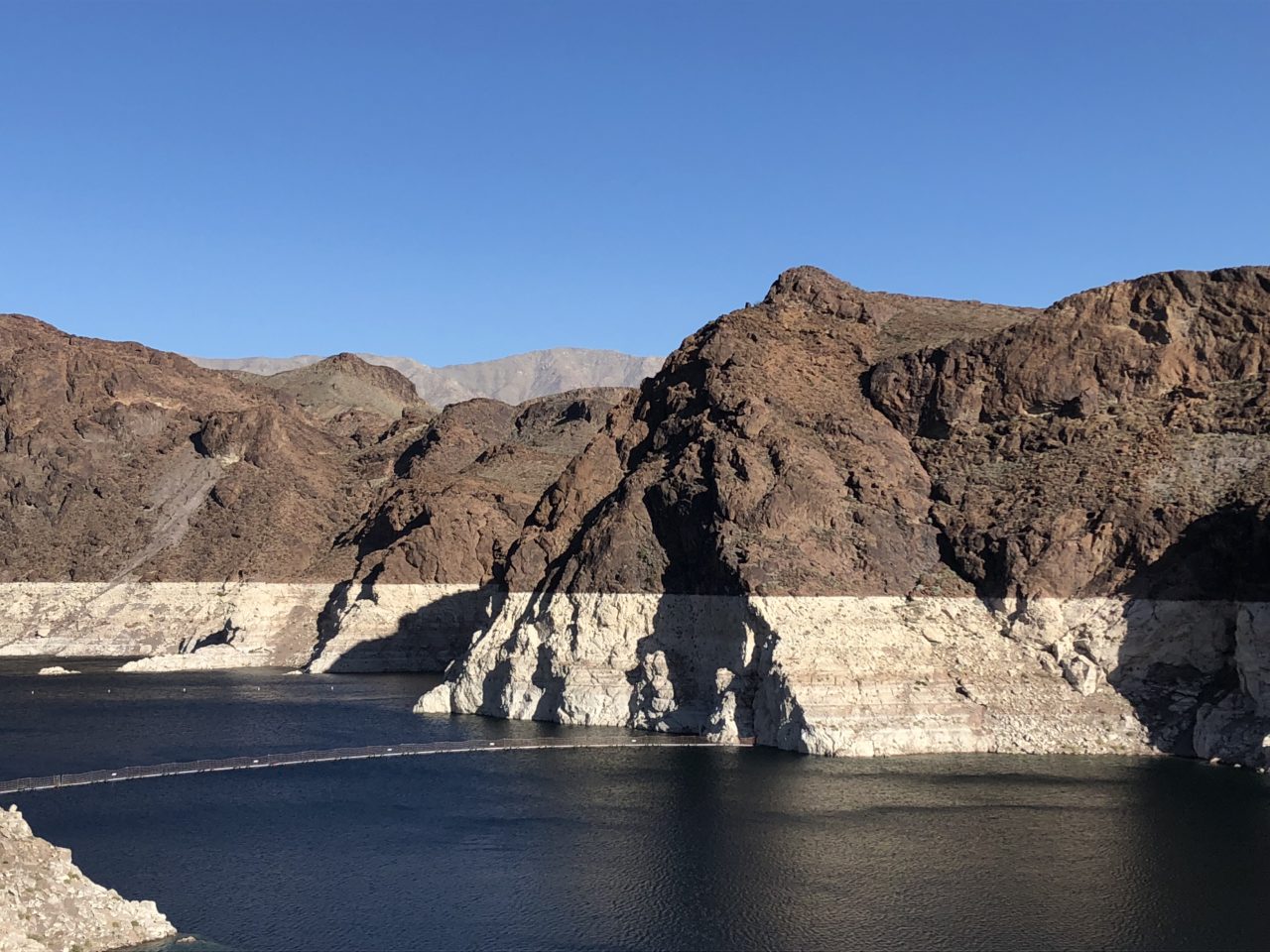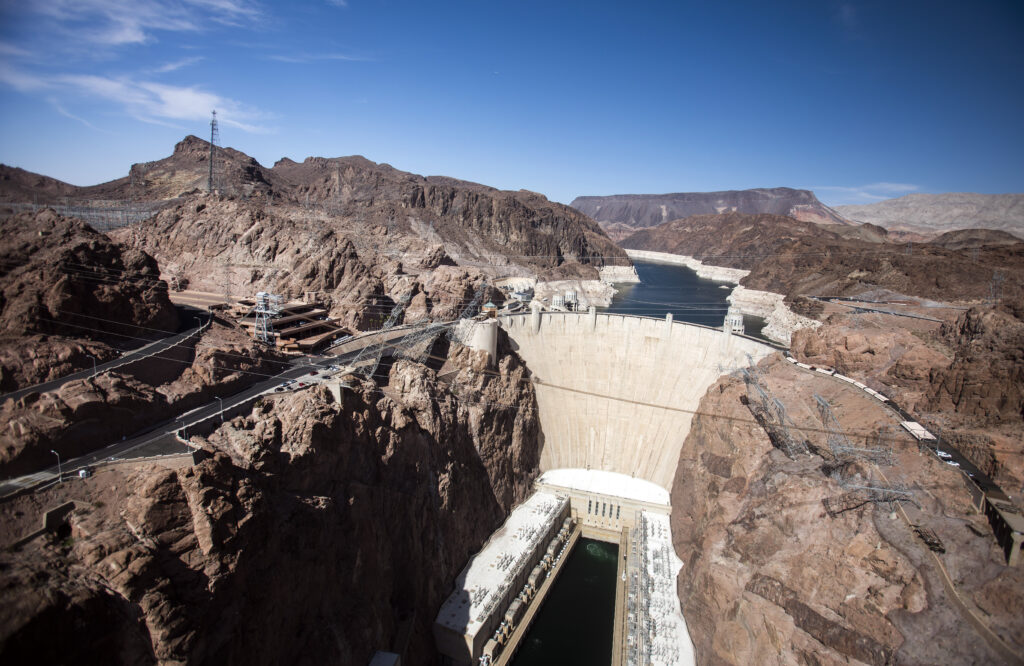Is customer-based water conservation a drop in the bucket in Southern Nevada?

Reduced precipitation from climate change and disputes over Colorado River water rights loom over Nevada’s water supply, but the agency that oversees it says officials can manage the uncertainty with a boost from new conservation programs and legislative mandates.
The Southern Nevada’s Water Authority’s (SNWA) Joint Water Conservation Plan was approved by the board’s seven member agencies in December, after significant updates to the conservation formula and strategies for 2019 through August 2024, when the five-year plan will be updated.
“Beginning in 2000 and continuing today, the Colorado River Basin has experienced drought conditions that quickly developed into the worst drought in the basin’s recorded history,” the plan says.
But the water authority maintains that it is on track to sustain its 2.1 million customers through the years when the water supply is unpredictable or below projections.
“Despite those additional half a million people moving to the valley, we are actually physically depleting the Colorado river by 25 percent less than we were in 2000,” said Colby Pellegrino, water resources director for the authority.
While Southern Nevada’s water stores are shrinking, its population is among the fastest-growing in the nation. A Census Bureau report published in April ranked Clark County the second-fastest growing county in the U.S. — an increase of about 48,000 people between 2017 and 2018.
Lake Mead stores about 90 percent of Southern Nevada’s water supply. Locals and visitors who observe the growing “bathtub ring” — the discolored band of rock above the lake’s surface marking where the higher water level used to be — might wonder: Will the region be able to sustain the trends in population growth?
In August, the Bureau of Reclamation announced that Arizona, Nevada and New Mexico would be required to “give up” portions of each state’s respective Colorado River allotment, to ensure that water won’t run out if the drought continues or worsens. These contributions take the form of Intentionally Created Surplus or “ICS” credits — water that is considered to be part of the state’s annual allotment of Colorado River, but remains unused and is returned or “banked” in Lake Mead for times of federally declared drought.
According to the SNWA conservation plan, “banked resources” are being used flexibly to meet demands and offset any future reductions in water supply, meaning water that has gone unused in previous years count toward the supply of available water, in times of drought. Because Southern Nevada uses approximately 80 percent of its allotment and has been banking the rest over recent years, authorities say that the region has enough saved up to get through the 2020 drought cuts without affecting water deliveries to customers.
The conservation plan reports that the water authority has banked approximately two million acre feet as surplus credits (ICS) through 2018, more than enough to cover the 8,000 acre-feet contribution that federal water managers required Nevada to put into the waning river.
By racking up ICS credits and setting consumption goal of 105 gallons per capita per day (GPCD) by 2035, the water authority hopes to be able to sustainably service more people with less water in the coming years.

Every drop counts
Updates to the conservation plan come after the Legislature approved AB163 earlier this year, a bill requiring utility companies to increase efficiency standards for plumbing fixtures in new construction. Because of these new provisions, the water authority’s member agencies will work on decreasing the number of gallons per flush or per minute by as much as 32 percent starting next year, when the bill becomes effective.
“The water authority has stressed that anything that enters our plumbing system can be recycled. But I think we hit an agreement with this bill that we want to encourage recycling indoor use as well,” Democratic Assemblyman Howard Watts said earlier this month. “This is to make sure every part of the state is being efficient with our water resources.”
Watts, who introduced AB163 during the 2019 legislative session, said that the new law aims to codify what the water authority and its member agencies already are measuring and to make that information available and accessible to the public.
According to the water authority, almost 100 percent of indoor water use in Southern Nevada is recycled back into Lake Mead. The bill says that the Legislature-approved plumbing fixtures will apply for newly constructed units and be implemented through local legislation that directs water agencies to use only approved fixtures and phase out older, less efficient ones.
“We do not play a role in our customers upgrading toilets, urinals, shower heads and faucets,” said Pellegrino, the water resources director for SNWA. “[The efficiency standards] are prescribed by the Legislature [and] that legislation directs the governing municipalities to adopt them into their codes and regulations so that products [that do not meet the new standards] are no longer sold and installed within the Las Vegas Valley.”
To further curb water waste, the water authority said that its member agencies have been ramping up more punitive fees for high water users since 2017. Currently, repeat violators are assessed water waste fees on their water bills beginning as high at $80.
According to the water authority’s estimates, since 2002, Southern Nevada jurisdictions have conducted more than 222,000 water waste investigations and assessed more than $2 million in fees to water wasters. This year, more than 14,000 investigations were completed, of which 1,377 resulted in a fine.
Water authority officials attribute the low incidence of fines to customers’ willingness to change their behavior once they are made aware of profligate consumption.
To work toward meeting the new efficiency standards, the water authority has started piloting smart leak detectors to customers who apply for the rebate coupon, which gives 50 percent off the cost of the detection device, up to $200. The devices connect with smartphones and provide customers with emergency notifications regarding leaks or other irregular water usage occurrences.
Pellegrino said that the devices, which have been distributed to 100 customers over the course of this year, are still in a small-scale “pilot” phase. More testing will be necessary to break down the cost-benefit and conservation impact of customers using the devices.
Measuring consumption and conservation
The water authority uses gallons per capita per day (GPCD) as one of its main conservation metrics and has updated the GPCD formula from previous years to account for “return flows,” or water that is recycled back into the Colorado River. Per the Joint Water Conservation Plan, the water authority has started subtracting recycled water from total water diverted, before dividing by the number of customers.
Gallons per capita per day is generally a measurement of gallons of water use per person. Traditionally it is calculated by total water diverted divided by the customer population. To put that in perspective, one toilet flush typically consumes about 1.5 gallons, and one minute of running a showerhead or tap consumes 2.5 gallons.
With the new GPCD formula, the water authority shows a decline from 1998 to 2018, from 189 to 113 GPCD — a net 40 percent reduction in water use per customer per day. The water authority is hovering around the 105 GPCD benchmark goal stated in the conservation plan. The decline has not been steady, however.
Because GPCD accounts for population growth, it can be an effective metric to measure changes in water-use efficiency over time. As of 2017, the water authority’s service population was more than 2.1 million customers, and its water use is accounted for separately from park service jurisdictions, the Bureau of Reclamation or the U.S. Fish and Wildlife Service.
The resort category composes about six percent of the authority’s water consumption. Those customers in particular welcome on average 40 million annual visitors to swim in their pools, enjoy giant water shows choreographed to music and use facilities and all the associated laundry services. According to Bronson Mack, spokesman for the SNWA, water consumption by these 40 million visitors can be classified as indoor “non-consumptive” or recycled use.

Las Vegas and other municipalities tend to calculate GPCD differently based on factors like climate, demographics, water-use accounting practices and economic conditions.
“In terms of total Colorado Basin supplies, subtracting return flows is the best way to account for a community's water use, because that water is available for reuse by others,” said John Fleck, director of the University of New Mexico Water Resources Program. “Best practices in water accounting always try to account for return flows. That's easier to do for Las Vegas, where you can measure the flows in Las Vegas Wash, and harder on farms, where drainage water percolates into shallow aquifers or via drains to a river.”
On the other hand, Michael Cohen from the Pacific Institute says that the change in the GPCD formula might make it harder for the water authority to compare its conservation efforts with other municipalities that share the Colorado River.
“It's an apples to oranges comparison by the way they've done it,” Cohen said in an interview with The Nevada Independent. “Conventionally, agencies calculate GPCD as total water deliveries divided by total service area population. Subtracting return flows from the delivery volume dramatically reduces reported GPCD and means that value is not comparable to GPCD reported by other water agencies.”
Cohen added that the change in formula showed that there are still “shifting terms” and conservation metrics, and that the federal government generally does not keep a record of different regions’ conservation data, for comparison.
Incentive pricing
Mack says that adjusting outdoor irrigation timers is the most important strategy when it comes to conserving water. Some of the most common types of water waste discovered by appraisals include outdoor leaks and not following time-of-day and seasonal watering schedules, as prescribed by the water authority.
While enforcement and penalties fall to member agencies, the water authority assists by mailing notices to “high water users” and offering on-site appraisals to these residential customers. According to Mack, as of last year, the water authority completed 190 on-site appraisals and is beginning to see an average water savings of 35,000 gallons per home per year.
“These savings are really the result of customers changing water use practices and behavior, rather than retrofitting fixtures or implementing other permanent water-saving measures like removing grass,” Mack said.
What about charging more for water, to create conservation incentives for customers, especially those who are considered to be “high water use”?
The Las Vegas Valley Water District, the water authority’s largest member agency serving 400,000 customers, has been modifying its tiered-rate structure since 1990, increasing the number of tiers over the years so that customers that use more generally pay more. But critics have said that a letter in the mail or a few more dollars on the next bill are a slap on the wrist for wealthy communities and their homeowners associations in urban developments such as Anthem and Summerlin in Las Vegas.
Watts served on a citizens advisory committee for the Las Vegas Valley Water District in 2016 and 2017, where he weighed in on the utility’s tiered rate system.
“When it comes to how water is paid for, Southern Nevada does not have the steepest tiered rates. And tiered rates are a conservation mechanism — increasing the price of water is a good way to send a signal to folks to be more efficient with that resource,” Watts said. “I asked that folks look into creating a new tier targeted at the most profligate water wasters, to be punitive, to get their water waste in line and to help fund other conservation programs like rebates. And that, ultimately, hasn’t moved forward.”
In terms of financing water resources and infrastructure, Clark County commissioners in July made permanent a quarter-cent sales tax that some critics say subsidizes the price of water to the benefit of the hotel industry. The water authority’s general manager, John Entsminger, said the revenue would be used for infrastructure projects.
“I do believe that the sales tax is generally a regressive measure,” Watts said, meaning it disproportionately hurts poorer residents. “I wouldn’t say tourists aren’t contributing at all. Of course, whenever they’re coming and spending on food and drink and goods at malls, they are contributing to the sales tax in Nevada.”
Climate change, population growth and water use by other delivery agencies who share Southern Nevada’s water stores make Southern Nevadans hold tight to the adage, “In the West, whiskey is for drinking and water is for fighting.” Regardless of who pays for it, Southern Nevadans have a shared investment in regional conservation efforts, and want to make sure revenues and efforts expended are setting them up for a sustainable future — a conceivable reality, based on conservation data.
“Southern Nevada has been under its Colorado River entitlement year after year after year despite significant population growth,” Cohen said. “I guess there's the point that population could exceed available water supply. But, certainly looking at the trend line, I would say they've done a very good job getting the math under control and living within their available water supply.”
Daniel Rothberg contributed to this story.
